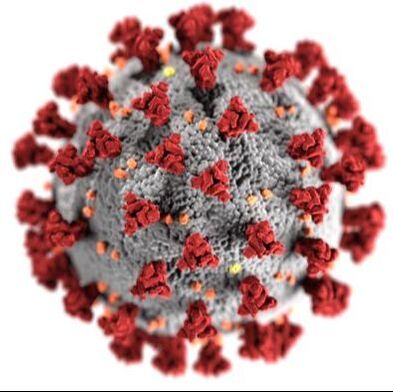COVID-19 Information and Symtoms
How does COVID-19 Spread?So if COVID-19 is so new, how do we know so much on how the virus is spread. The fact is scientist have been studying coronaviruses for many years, most people do not know that when we say we have a 'cold' it is most likely caused by a viral upper respiratory infection of which there are 100's if not 1000's of different types. Generally they have mild to moderate symptoms and the body is able to fight them off in a matter of a few days.
Four of these milder versions are actually coronavirus variants which are HCoV-229E, HCoV-OC43, HCoV-NL63, and HCoV-HKU1. In the last 2 decades three new (or novel) coronaviruses have emerged. These variants have significant differences from the previous coronaviruses, including causing lower reparatory infections often including the lungs which can easily turn into pneumonia. The newest coronavirus variants are SARS-CoV (now being called SARS-CoV-1), MERS-CoV and of course SARS-CoV-2 or COVID-19. You may have remembered SARS (c. 2003) and MERS (c. 2012) being mentioned on the news. While all of the seven (known) coronavirus that can infect humans have drastically different symptoms they all spread in the exact same manner, the CDC states, COVID-19 is thought to spread mainly through close contact from person to person, including between people who are physically near each other (within about 6 feet). People who are infected but do not show symptoms can also spread the virus to others (CDC, Oct 2020). Furthermore we know that in particular that the coronavirus can easily spread via reparatory droplets in the air. It has been noted that,
Do I have COVID-19If you suspect you have COVID-19 call your primary healthcare provider first or go to a testing site. It is critical that you you think you have been exposed or are showing symptoms of COVID-19 that you take precautions to not spread the virus to others. If you are experiencing shortness of breath or difficulty breathing call 9-1-1 or go to an emergency room at your nearest hospital, make sure to wear a mask if possible and immediately state that you have been exposed to COVID-19 or are showing signs and symptoms.
COVID-19, Cold, Flu, Allergies or Asthma
Prevention and Saftey PracticesNow that we know how the disease is spread we can talk about prevention. There are three primary ways you can prevent infection is:
Social DistancingNow we need to talk about why this works if you have never or are new to healthcare this is all new to you, while the news is clear about why we should practice these two option they are not clear on they why or how.
Touch: Humans are, in a general sense, social creatures, so of us are introverts and some extroverts but rarely do we not interact with any other humans at all. It is quite normal for us to shake hands or give a hug to someone. In fact, one study showed that human touch can reduce the perception of loneliness, lower heart rates, and feel less neglected (Heatley, 2020).
Wearing a Mask
Washing Your HandsAccording to the Centers for Disease Control;
Washing your hands is easy, and it’s one of the most effective ways to prevent the spread of germs. Clean hands can stop germs from spreading from one person to another and throughout an entire community—from your home and workplace to childcare facilities and hospitals. Vaccination and InformationVaccine RolloutThe COVID-19 Vaccine is not mandatory, however the CDC and Texas Health and Human Services recommends that every person be vaccinated to achieve "Herd Immunity". Everyone should be vaccinated based on the rollout phases. As of right now Phase 1a and Phase 1b have been started and information from the Texas Department of State Health Services state:
Phase 1a (Active Now) - Front-line healthcare workers and residents at long-term care facilities this includes PAS agency attendants and supervisors; Home health and hospice agency employees, volunteers and contractors as directed by DSHS on February 5th, 2021 If you have a condition that is not listed it is recommended that you speak with your doctor to see if you qualify for the vaccine. Sources:
Centers for Disease Control (CDC). (2020, October 28). How Coronavirus Spreads. https://www.cdc.gov/coronavirus/2019-ncov/prevent-getting-sick/how-covid-spreads.htmlHeatley Tejada, A., Dunbar, R., & Montero, M. (2020). Physical Contact and Loneliness: Being Touched Reduces Perceptions of Loneliness. Adaptive human behavior and physiology, 1–15. Advance online publication. https://doi.org/10.1007/s40750-020-00138-0 Van Kerkhove, M., Gupta-Smith, V. (2020, September 4). WHO's Science in 5 on COVID-19 - SARS-CoV-2 virus. https://www.youtube.com/watch?v=Rg6Tf5ZN5rQ Centers for Disease Control (CDC). (2020, November 24). How and When to Wash Your Hands. https://www.cdc.gov/handwashing/when-how-handwashing.html Texas Department of State Health Services (DSHS). (2020, February 5). COVID-19 Vaccination Information. https://dshs.texas.gov/coronavirus/immunize/vaccine.aspx |
The Company About Us | Contact UsResourcesLegal |
© COPYRIGHT 2020. ALL RIGHTS RESERVED.





